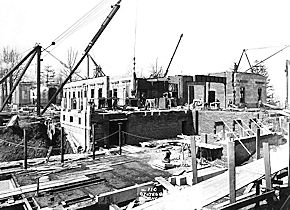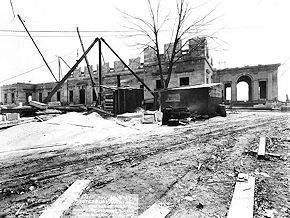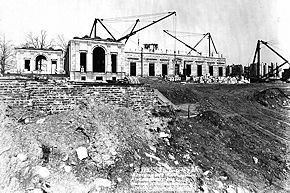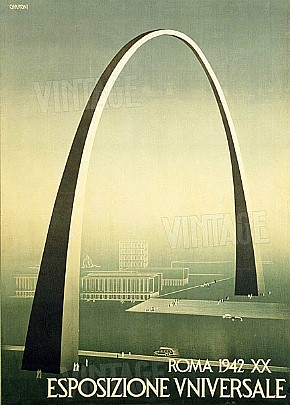  
Horace Trumbauer, Whitemarsh Hall (Wyndmoor, PA: under construction, 1917.04.04).
| |
2000.04.04 20:39
rammed into an envelope
John Young wrote:
What is peculiar to me is the conviction that the visual in architecture should not evolve from the full implementation of its attributes, not as an envelope into which these attributes should be rammed.
Gregory Wharton wrote:
Well said. This puzzles the hell out of me, too.
Van Varga wrote:
Probably puzzles most of us. Architecture to non architects (most people) is just another expression of fashion. (snip)
Steve Lauf suggests:
Is not the 'architecture' of the human body an envelope rammed full of 'attributes' that DO NOT show their 'implementation' on the outside? For example, breasts with nipples hardly reflect either the lungs or the pumping heart inside, likewise the one-piece torso offers little 'superficial' indication of two cavities inside. And further, isn't the sublime singularity of the navel very much like the exact opposite of the twisting, turning, asymmetrical intestines just inside? [And just think how literally close the activities within barber shops and beauty parlors come to the activities inside the brain, yet who would dare say that these two activities share the same "function"?]
Perhaps the 'popularity' of liking the 'mechanical' out of sight is really only a reflection of simply being human.
Personally, it's no puzzle to me.
2002.04.04 10:49
Re: [art] being/appositional [architecture]
In general, appositional here refers to the notion of:
applying (one thing) to another
and
deposition of successive layers upon those already present
Beyond that, the questions I raised here yesterday involve the notion that architecture (over the ages) has largely been apposed with other art forms or with other engineering forms. I thought it would be interesting to openly discuss what those 'other' yet directly near applications are or are not, and how the appositions change or don't change the 'original' layer. For that matter, identifying what the original layer is may also evoke interesting positives and negatives.
2002.04.04 16:48
Re: [art] being/appositional [to architecture]
Are there such things (in design) as difficult appositions?
Is coming to grips with difficult appositions something designers should be aware of or be willing and/or able to deal with?
2004.04.04 19:24
Re: 1 more 1 is 2 yet .33
Two places for bilocation is a given. I'd sooner search for two places, and, if two places were found, then I'd begin wondering about multilocations.
2004.04.04 19:26
Re: 1 more 1 is 2 yet .33
That bilocation is extremely rare is (I think) another given.
| |
2005.04.04 09:57
Rome before St. Louis
The arch proposed for the Esposizione Universale Roma 1942 -- EUR...

...was designed by Adalberto Libera in 1937-1942.
The St. Louis Arch design was won by Saarinen in a 1947 competition.
2005.04.04 11:52
Re: Rome before St. Louis
appropriated 2 : To take possession of or make use of exclusively for oneself, often without permission: Lee appropriated my unread newspaper and never returned it.
Close to plagiarize.
What's next, public domainism?
2005.04.04 16:58
Re: Rome before St. Louis
... the St. Louis Arch footprints are triangles, with the points facing each other.
| |
2006.04.04 12:11
Re: Constantine and Christians
...read the passages within Eusebius' Life of Constantine, Book III, Chapters 54-58, demolition of the shrine at Aphaca in particular. These demolitions of pagan temples are recorded immediately following the chapters about the Christian church building projects in the Holy Land and other locations in the East. I find the (historical) juxtaposition of Constantine's creative and destructive religious activities interesting--while Christianity was beginning to be 'built', paganism was starting to be 'demolished', and seemingly starting with the more homosexually oriented cults.
2006.04.04 12:51
Re: Constantine and Christians
It is perhaps wrong to say that Constantine was influenced by Helena and Eutropia when it came to Christianity, but there is no question that Constantine acted in tandem with Helena and Eutropia when it came to manifesting Christian churches. Helena's work is relatively well know here, but Eutropia's work is often ignored. Here is a letter from Constantine to Eusebius (as a bishop in Palestine), which Eusebius includes within the Life of Constantine after recording the death of Helena:
"VICTOR CONSTANTINUS, MAXIMUS AUGUSTUS, to Macarius, and the rest of the bishops in Palestine.
"One benefit, and that of no ordinary importance, has been conferred on us by my truly pious mother-in-law, in that she has made known to us by letter that abandoned folly of impious men which has hitherto escaped detection by you: so that the criminal conduct thus overlooked may now through our means obtain fitting correction and remedy, necessary though tardy. For surely it is a grave impiety indeed, that holy places should be defiled by the stain of unhallowed impurities. What then is this, dearest brethren, which, though it has eluded your sagacity, she of whom I speak was impelled by a pious sense of duty to disclose?
That the Saviour appeared in this Place to Abraham. She assures me, then, that the place which takes its name from the oak of Mambre, where we find that Abraham dwelt, is defiled by certain of the slaves of superstition in every possible way. She declares that idols which should be utterly destroyed have been erected on the site of that tree; that an altar is near the spot; and that impure sacrifices are continually performed. Now since it is evident that these practices are equally inconsistent with the character of our times, and unworthy the sanctity of the place itself, I wish your Gravities to be informed that the illustrious Count Acacius, our friend, has received instructions by letter from me, to the effect that every idol which shall be found in the place above-mentioned shall immediately be consigned to the flames; that the altar be utterly demolished; and that if any one, after this our mandate, shall be guilty of impiety of any kind in this place, he shall be visited with condign punishment. The place itself we have directed to be adorned with an unpolluted structure, I mean a church; in order that it may become a fitting place of assembly for holy men. Meantime, should any breach of these our commands occur, it should be made known to our clemency without the least delay by letters from you, that we may direct the person detected to be dealt with, as a transgressor of the law, in the severest manner.
For you are not ignorant that the Supreme God first appeared to Abraham, and conversed with him, in that place. There it was that the observance of the Divine law first began; there first the Saviour himself, with the two angels, vouchsafed to Abraham a manifestation of his presence; there God first appeared to men; there he gave promise to Abraham concerning his future seed, and straightway fulfilled that promise; there he foretold that he should be the father of a multitude of nations.
For these reasons, it seems to me right that this place should not only be kept pure through your diligence from all defilement, but restored also to its pristine sanctity; that nothing hereafter may be done there except the performance of fitting service to him who is the Almighty God, and our Saviour, and Lord of all. And this service it is incumbent on you to care for with due attention, if your Gravities be willing (and of this I feel confident) to gratify my wishes, which are especially interested in the worship of God. May he preserve you, beloved brethren!"
I think it is clearly implied that Constantine sooner trusts Eutropia than the Christian bishops, and, moreover, Eutropia provided Constantine with a further occasion to demonstrate his superiority over the bishops. What is unfortunate is that modern scholars cannot accept that Eutropia was still alive and still on good terms with Constantine after the deaths of Helena and (of course) Fausta.
I've said it here before, and I'll say it again: a lot of the conundrums of Helena cleared up once I stopped ignoring Eutropia.
To me, Constantine was a soldier first, a politician second and a Christian third. Helena, I see, as a great historical player, a great survivor and a great doer. And, I see Eutropia, because of her long Imperial life and vast experiences, as the person closest to Constantine who knew 'everything'--she knew the Empire and its many places and how it all worked (literally and symbolically), and she probably knew who owned what.
2008.04.0412:36
READING LIST
Currently reading Privacy and Publicity: Modern Architecture as Mass Media, and got up to p. 84 yesterday morning while waiting for the repair of an automatic car window. There is an unfortunate manuscript error on page 68:
lines 1-4
Benjamin cites a sentence of Theodor Reik... Remembrance is essentially conservative; memory is destructive."
lines 14-15
In these terms, Reik's distinction between conservative memory and destructive remembrance...
As they stand (at least in the 1994 hardback edition), these lines contradict each other, and thus completely confuse the issue. Now checking the source, lines 1-4 correctly recall Reik's distinction.
Staying on page 68, I (personally) use/translate Erfahrung as 'a knowledge of', and Erlebnis as 'an actual experience of', in the sense that Erfahrung is more or less a reenactment of Erlebnis.
2008.04.04 13:56
READING LIST
I can't answer for others, but lately my architectural theories involve a conjunction of Erlebnis und Erfahrung.
13040401 New Not There City site plan development 2413i12
16040401 Herzog & de Meuron Tacheles Site Development Berlin
18040401 IQ63s16 Surface Building 04 model 2470i04
18040401 OMA The Qatar National Library Doha
20040401 iiq08 model work 2348i33
|